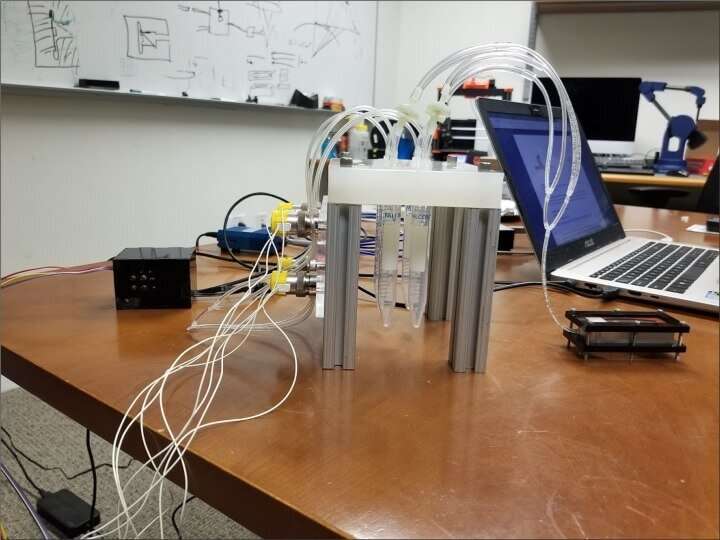
The experimental setup. The sensor sits on top of a small glass box (left). A small amount of liquid containing VOCs (on the right) is added to the box, where it is brought to the sensor by sniffing. Source: Aizenberg Lab/Harvard SEAS
Think about it—there’s no cheap, at-home tool that can tell you that milk is going bad faster than your nose. A boil and you know the milk is spoiled. People have developed technologies that allow us to see distant stars and an atom but when it comes to smell, the nose still has the best knowledge.
Portable sensors that mimic the olfactory system, known as e-noses, can be used to detect volatile compounds in the air. However, these devices have not been widely used until now because they can be large, have complex manufacturing, detect only one or a few compounds, or have inaccuracies. Toxic spills, such as the East Palestine, Ohio, train derailment in February, highlight the need for portable and inexpensive sensors that can quickly and accurately identify refined compounds at the site.
Now, a research team led by the Harvard John A. Paulson School of Engineering and Applied Sciences (SEAS), introduced an easy-to-manufacture e-nose that quickly and accurately “sniff-out” volatile compounds, such as the ubiquitous volatile organic compounds (VOCs). The sensor is the first of its kind to feature passive and active sensing with a single sensor and uses machine learning to identify different molecules and their mixtures.
“Different from our approach, our sensor implements biologically inspired ‘sniffing.’ It produces patterns of inhale-exhale sequences, mimicking the critical odor discrimination mechanism used by living organisms, which includes not only chemical sensing but also dynamic mass transport processes,” said Joanna Aizenberg, Amy Smith Berylson Professor of Materials Science at SEAS, Professor of Chemistry & Chemical Biology, and lead author of the study.
“Our results show that this unique feature increases the detection power of any artificial nose, with many applications in breathalyzers for disease diagnostics, monitoring air quality and hazardous waste, or detecting food spoilage.”
The research was published in Proceedings of the National Academy of Sciences.
VOCs: Benign, deadly, life-saving
VOCs are released into the air from both natural and man-made sources. They are everywhere—used for everything from cosmetics to furniture and emitted from agricultural activities, car exhaust, fires, industrial processes and more. VOCs range from harmless to deadly, so measuring their presence, concentration, and identity is essential for monitoring indoor and outdoor air quality and hazardous waste. New research has also found that measuring VOCs in breath and urine can detect some cancers in early stages.
Today, most of the devices used to detect and quantify VOCs in the air rely on sophisticated instruments that are bulky and require specialists to operate and interpret. Researchers are developing e-noses as portable, practical, reliable, and easy to read alternatives.
Instead of trying to mimic millions of individual receptors in the nose—which would lead to large and difficult-to-manufacture devices—Aizenberg and his team used a sensor to detect the optical properties of the molecules that make up the various VOCs.
The sensor has alternating layers of silica and titania nanoparticles with tiny pores between them. The sensor sits on top of a small glass box into which a small amount of liquid containing VOCs is added. As the liquid evaporates, the gas moves into the pores of the sensor, where it adsorbs and condenses. As these processes occur, the refractive indices of each of the sensor layers increase, which causes the color of the sensor to change.
“The problem is that the refractive indices of different gases are very similar. This means that the color of the sensor will look almost the same at the end of an experiment, no matter what gas you use,” said Ida Pavlichenko, co-first author of the paper and the creator of the project during her time as a postdoctoral fellow in Aizenberg’s lab.
However, the team found that changes in the sensor’s refractive index change differently for different compounds over time, creating a kind of dynamic spectral fingerprint for each VOC.
“The rates of all processes—from the formation of a droplet at the bottom of the chamber to its evaporation, rise in the chamber, and arrival at the sensor—depend on the unique microscopic forces between the molecules present,” said Anna V. Shneidman, a research associate in the Aizenberg lab and co-first author of the paper. “Therefore, the sensor’s color changes over time look very different even for the same VOCs such as 5-carbon molecule pentane and 8-carbon molecule octane.”
The team identified specific parts of the dynamic reflection spectrum of each compound and used those parts to train a machine learning algorithm to identify specific VOCs, determine the concentration of each VOC in a liquid mixture, and accurately predict the physical properties of volatile liquids.
“Machine learning can improve the ability of even these simple sensors to do amazing things,” Shneidman said.
“In this work we use a simplified mapping model from the odor space of experiments to chemical species. With larger datasets, we can create more sophisticated models with better discrimination power,” said Michael P. Brenner, Michael F. Cronin Professor of Applied Mathematics and Applied Physics at SEAS and Professor of Physics, and co-author of the paper.
Hurry
To speed up the sensing process and provide the machine learning algorithm with more data, the team turned to sniffing.
If you’ve ever seen a dog sniff something in its path, you’ll know that dogs use quick, staccato bursts of sniffing and longer breathing.
“Dogs and other mammals, including humans, can actively modulate the timing, rate, and depth of sniffing. That behavioral observation, as well as many neuroscience experiments, clearly shows that the brain uses the dynamics of the smell sensation to make inferences about odors,” said Venkatesh Murthy, the Raymond Leo Erikson Life Sciences Director of the Harvard Sciences Finnecular at Molegan and the Family Sciences J. and colleagues g author of the paper.
The researchers found that different sniffing patterns also changed the way the molecules interacted with the sensor. The rates of diffusion, absorption, condensation, and desorption change with different lengths of inhalations and exhalations.
“With different sniffs and exhales, we can begin to tell apart compounds that were previously difficult to differentiate,” said Haritosh Patel, a Ph.D. candidate at SEAS and co-first author of the paper. “In nature, the concentrations of these compounds vary greatly. One type of compound may require a shorter sniffing pattern so you don’t overexpose your sensor, while in situations where the concentrations are very low, you may want to take longer breaths to saturate the sensor.”
“The size, flexibility and ease of manufacture make our sensor more versatile than many commercial sensors and adaptable to a wide range of compounds and odors,” said Soeren Brandt, a former graduate student at SEAS and co-first author of the paper. “Compared to other e-noses, they are easier to manufacture, use, reuse, and maintain. Our work is a blueprint to make more efficient and cheaper e-noses.”
More information:
Brandt, Soeren et al, Nonequilibrium sensing of volatile compounds using active and passive analyte delivery, Proceedings of the National Academy of Sciences (2023). DOI: 10.1073/pnas.2303928120. doi.org/10.1073/pnas.2303928120
Awarded by the Harvard John A. Paulson School of Engineering and Applied Sciences
Citation: AI-enabled portable e-nose sniffs out harmful molecules (2023, July 25) retrieved 25 July 2023 from https://phys.org/news/2023-07-ai-enabled-portable-e-nose-molecules.html
This document is subject to copyright. Except for any fair dealing for the purpose of private study or research, no part may be reproduced without written permission. Content is provided for informational purposes only.
